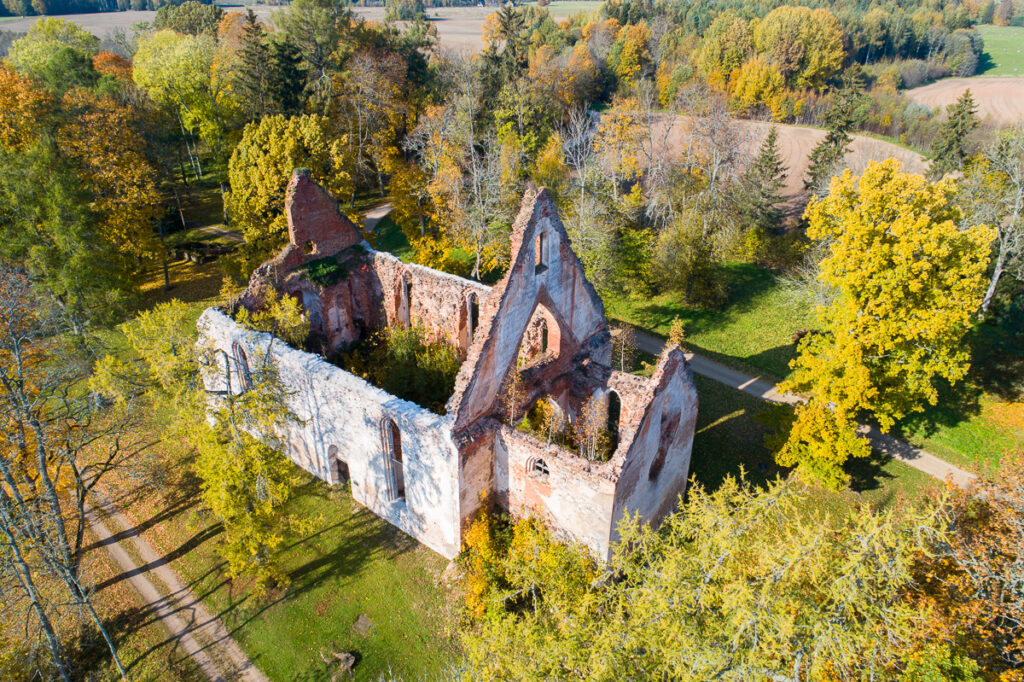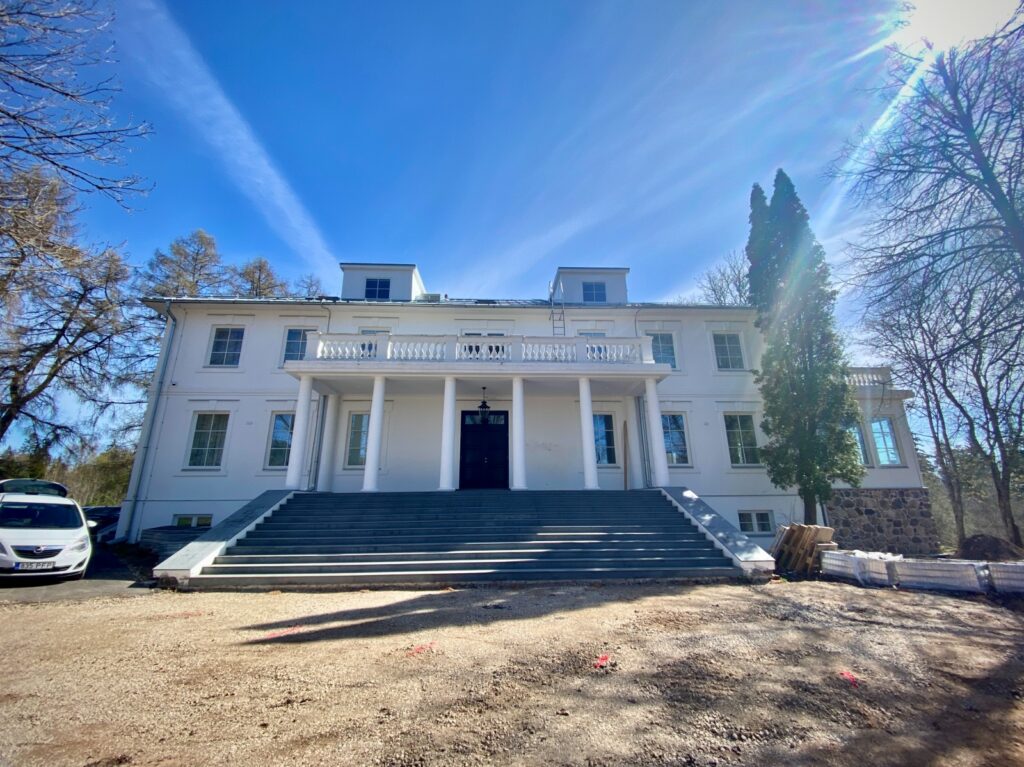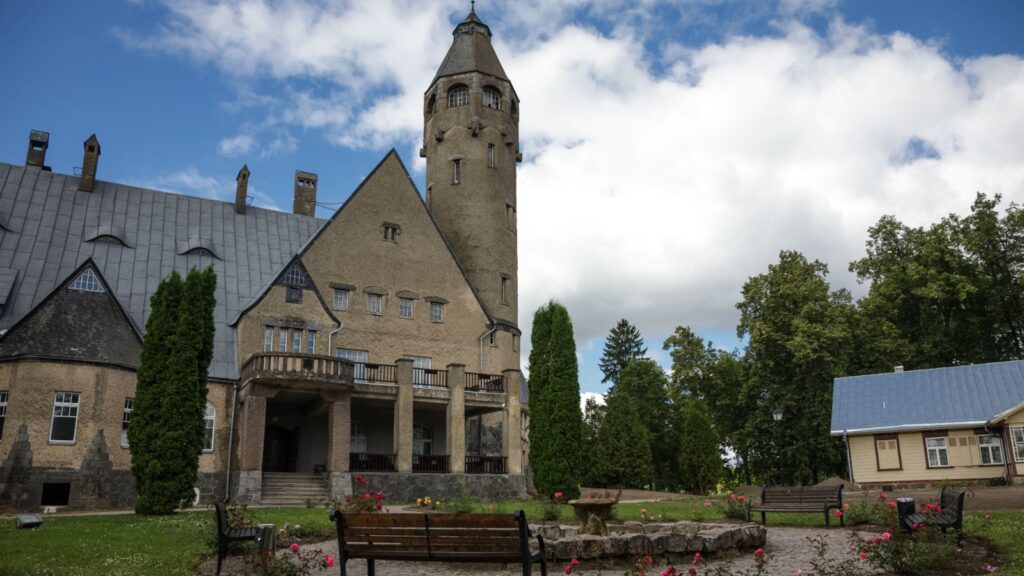There is no shortage of manors in Tõrva parish which is situated in the boundaries of historical Helme parish. A true lover of architecture and history will find some very unique manors to explore. Here we publish a list of manors located in Tõrva parish, some of which have unfortunately surrendered to the wear and tear of time.
Ala knight manor and Aitsra (support manor of Ala manor)
The main building has been destroyed and the site is marked by a ruin which suggests that it was a small building, probably made of wood. The auxiliary buildings have also been destroyed and only a granary-dryer, stable and park have survived which gives reason to believe that this was a small manor complex.
Helme knight manor and Helme church manor
In the 17th century, Helme manor, which was built a few hundred meters east of the castle, began to set the tone instead of Helme castle. When Southern Estonia came under Swedish rule in the 1620s, the well-known Swedish military leader Pontus de la Gardie became the owner of the manor. From 1892 until its dispossession in 1919, the manor belonged to the von Stryk family from Riidaja manor.
The Edler von Rennenkampff family completed the construction of a more striking manor in the second half of the 18th century. The one-storey early classicist manor, which has survived to this day, was built in the 1770s. The building, which was rebuilt inside and partly outside, operated for a long time as an agricultural school. Only a few of the manor’s auxiliary buildings have survived, albeit in a rebuilt version. Probably the world’s first monument for Friedrich Schiller was erected in the manor park in the 19th century, but it has not survived.
Helme church manor is known by the Helme Parish Museum, which is located in the village of Kirikuküla, in the former pastoral building of Helme church. The Church of the Holy Virgin Mary in Helme was a Lutheran church, of which only ruins have survived.

Holdre knight manor
Holdre manor was first mentioned in the 16th century. From 1630 to 1767 it belonged to the Holler family, hence the name. Since 1909 the manor belonged to Patküla parish, since 1921 to Holdre parish and during that time it was first rebuilt into a school and then to parish center. In 1939, part of Holdre parish together with the manor were merged with Taagepera parish and renamed to Vaoküla parish
During the Soviet era, the manor school continued to operate until the spring of 1961. At the end of the Soviet era, the manor was used as a pioneer camp and the building belonged to Valga road repair company. Today the manor is privately owned and is being renovated. A piano museum should open in the manor in the coming years.
The chateau of Holdre manor was completed in 1910 and was built in Art Nouveau architectural style. The exceptionally beautiful building was designed by Otto Wildau.

Hummuli knight manor
Hummuli manor (German: Hummelshof) was first mentioned in 1470. In 1914, the manor was acquired by Ermes von Berg from Sangaste manor. As the owner of the manor acquired Finnish citizenship, the manor was not immediately dispossessed. Until 1929, the manor was rented by the von Bergs. The right corner of the clean-jointed brick building is adorned with a three-storey octagonal tower, ending with a serrated cornice.
After its dispossession, the building was used as a school for several decades and it has been slightly rebuilt in the 20th century to fit that need. Among other things, the original partitioned windows have been lost. Auxiliary buildings of the manor have not survived.

Jõgeveste knight manor
Jõgeveste manor (German: Beckhof) was separated from the neighbouring Helme manor in 1718. At the beginning of the 19th century, the manor belonged to Barclay de Tolly family who have Scottish roots. The manor has been made famous by the funeral chapel or mausoleum of the famous Russian military leader Barclay de Tolly which is located one and a half kilometres north of the manor center, on the high west bank of the river Väike Emajõgi.
Jõgeveste’s traditional manor center has almost completely been destroyed today – the one-storey stone main building was destroyed in World War II and the auxiliary buildings are left in ruins.
Koorküla knight manor and Asu (support manor of Koorküla manor)
Karl Ruut has written such a story: Once upon a time, there was a landlord in Valgjärve who was a very mean and greedy person. He forced peasants to work and paid them very little, ripping them off. That is why the landlord was called Koorja (word meaning peeler = cheater) and his village Koorjaküla (similar to cheater village), hence the name Koorküla. The landlord himself drowned in a lake, which later became known as lake Koorja (lake Koorja is the current lake Kuulja).
There are reports from 1487 of Kuerkull village and also Valgjärve manor. According to data from 1518, Corkülli manor was abandoned by lake Valgjärv which might be the source of legends of a manor that sank in lake Valgjärv. Koorküla manor was later established in its current place. The last owner was von Stryk, from whom the manor was dispossessed in 1920.
The building has now been destroyed. The current cultural house there is an auxiliary building of the former manor.
Koorküla manor was a long (28.5 × 13.5 m) log building with a basement, a first floor and a second floor in the middle. During the war, the house was not damaged, however, the locals started demolishing the house from the northern end. The other end of the building was occupied by Johanna Kurvits with her three sons and husband who was a well-known blacksmith. The surviving part of the manor decayed over the years and the Kurvits family moved to the smithy building. The wooden parts of the manor were taken by the local people to be used as burning material.
Leebiku knight manor and Vanamõisa Leebiku support manor
Leebiku used to be one of the largest rural municipalities in Helme parish. The territories of Leebiku reached all the way to the southern borders of the parish. There were several unmarried ladies in Leebiku manor who tended to be rather old and proud and were not able to get married. However, in order find a husband for his daughters, Leebiku’s estate owner was forced to give each son-in-law a piece of land and forest as a dowry. This is how the great lands of Leebiku were divided. Two cattle manors remained in Leebiku, Vanamõisa and Ajandu. The first of them is supposedly older than Leebiku manor and was the initial location of the manor.
Leebiku manor was first mentioned in 1531 and its current name comes from the Klebeck family. In 1896, Leebiku manor was bought by Estonian Jaan Hendrikson, who looked after the manor with his sons Wilhelm and Herbert. After the dispossession of manors, the heart of the manor was left to the Hendriksons which was a very rare example. The family left for Germany in 1939.
The manor also had a watermill which as a rare sight is still operational. 26 different tree species grow in Leebiku Park, which runs along the steep bank of the river Õhne. Among the rarest species are Siberian and balsam fir, eastern white pine, white poplar, Siberian and European larch. The park has a unique alley of pillar-shaped trees and a remarkable ancient oak which is 485 cm in circumference from chest height.
Lõve knight manor
Earliest mentions of the Lõve manor (German: Lauenhof) are from the middle of the 16th century while it was part of the then rather large Helme manor. In the 1750s, the manor was acquired by the von Anrepite family, who remained the owners until it was dispossessed in 1919. About 1760-70 the manor was rebuilt for the second time to a more grander version and one of the most magnificent baroque main buildings of the time in Southern Estonia was erected.
The main building of the manor was badly damaged during the War of Independence. Later, no use was found for the building and in the second half of the 1920s, the looted building was demolished for building materials. Only low corners of the walls on the grassy foundation have survived. To this day, however, several auxiliary buildings and a beautiful park have survived.
Patküla knight manor
The earliest record of Patküla manor dates back to 1517. Its Estonian name comes from the 16th – 17th centuries after the owners Patküll. From 1861 until its dispossession in 1919 the manor belonged to the von Stryk family. Patküla parish was formed in 1866.
The main building of the manor and the wooden chateau in the park have been destroyed. However, a striking pillared granary-dryer and the adjacent stable-coach house have been well preserved and are both architectural monuments.
Pokardi manor
The main building of the former manor, known to locals simply as Pokardi castle, was built in 1870. After the War of Independence the house was given to the war hero Aleksander Jaakson who remained the owner until the fall of the republic. During the Soviet era, the building was used as an orphanage and an auxiliary building for the former Helme boarding school.
After the independence of Estonia, the two-storey house was rebuilt into an apartment building and a shop operated in it for many years. Later, when the building was declared to be in danger of collapse, the house in a seemingly hopeless state went into private hands, where it stayed the way it was for years.
In 2014, the manor house was bought by businessman Nicos Kounnas and in 2016 restoration works began. In 2022, an exclusive boutique hotel should open in the manor.

Riidaja knight manor
The earliest records from Riidaja manor (German: Morsel Podrigel) date back to 1562. From the 16th century until its dispossession in 1919, the manor belonged to the von Stryk family. The last owner before the dispossession was Friedrich von Stryk.
The heart of the manor was largely built in the second half of the 18th century and the beginning of the 19th century. In 1762, a long and simple baroque wooden main building was completed in the manor. Riidaja manor house is one of the best preserved baroque wooden manor houses in Estonia today. The manor was dispossessed in 1919 and since 1923 a school operated in the main building and since 1967 it was the center of a kolkhoz named after J. Lyakhov. Today, Riidaja library operates in the building.
Soontaga manor
Soontaga manor was a forest manor located in the areas of Tõrva parish. The oldest record of the Soontaga manor (German: Sontack) dates back to 1439 when the bishop of Tartu, Klaus Holstver, sold the manor with a mill and 16 plough lands to Ludeke Zöge. The Zöges, who also owned the nearby Puka manor, kept the manor until Polish times. During Polish rule, the Swedish-supportive Zöges lost the manor and their heirs, baron Reinhold Gustav Ungern and Major General Wolmar Anton von Schlippenbach regained it in 1697.
In 1726, Soontaga manor was left to the free lord Carl Heinrich von Wrangell. Before 1776, the manor was bought by rittmeister Valentin Johann von Loewenstern, who merged it with his neighbouring Kuigatsi manor and Soontaga became a cattle manor.
In addition to the abundance of forests, the Soontaga creek has supported the development of forestry over agriculture and herding thanks to its stream gradient in the lower reach and stable supply of water from the Priipalu and Rooni marshes which helped to operate a relatively powerful sawmill (38 kW, 4 turbines in 1940). Convenient proximity to the river Väike-Emajõgi made it possible to deliver lumber even to the city of Tartu.
Soontaga manor received the status of an official forest manor before the First World War. Only a small area in the heart of the manor was left as arable land for millers, forest guards and woodcutters. After the independence of Estonia and the departure to Germany of the last forest manager of Aakre manor, Adalbert Walter, the Aakre forest district was formed from the forests of Soontaga and the surrounding manors, with an office in the Soontaga sawmill.
By the middle of the 20th century a wooden manor house (Aakre forest district office in the 1960s), a bull stable or Valgemaja (White House), a smithy (demolished in 1989 during the construction of a new forestry agency building) and the so-called Adler watermill had survived. The manor house is located in a miniature park, which is bordered by a hazel tree hedge to the east and the Soontaga creek and lake Veskijärv to the west.
Roobe knight manor
Mats Erdell (1793 – 1847), a peasant from Helme parish, managed to earn some nice money during the war in 1812 and later supported himself by trading grain and flax next to farming. By the end of the 1820s, Mats had become a rich man compared to other peasants of that time and he rented Patküla manor from artillery captain Reinhold Otto Freytag von Loringhoven. He was successful in managing the manor and developed a desire to become a landlord himself.
When a small manor house in Roobe, with good lands, went on sale, Mats decided to buy it. At that time, however, only a nobleman could own a manor. Mats tried to find a solution – he travelled to St. Petersburg and tried to buy the manor through the Ministry of Agriculture, but he was not given the permission. Mats did not give up and went to von Stryk in Voltvett and asked him to buy Roobe manor in his own name. Von Stryk agreed and bought the manor with Mats’ money. In 1833, he received the rights of the pledgee over the figurehead von Stryk, bought the manor’s pledges and became its actual possessor.
After the ownership of knight manors was released to members of all classes, his son Hans Erdell bought Roobe manor in 1867 for 18,000 silver roubles and became the first Estonian knight manor owner. Roobe manor remained in the hands of the Erdells until 1939 when members of the Germanized family left for Germany.
Taagepera knight manor and Taagepera-Vanamõisa (support manor of Taagepera manor)
The first records of Taagepera manor (German: Wagenküll) date back to the 16th century. At the beginning of the 17th century, the manor belonged to the von Rehbinder family and from 1819 the manor was owned by the locally legendary von Stryk family who remained the owners until its dispossession in 1919. Until the beginning of the 20th century, the heart of the manor consisted of rather modest buildings. Some of the rebuilt auxiliary buildings have survived to this day. At the beginning of the 20th century, the construction of one of the most characteristic and grand Art Nouveau castles in Estonia was started in Taagepera. The author of the design was architect Otto Wildau, who has also designed the main buildings of the nearby Holdre manor and Karksi manor.
The manor house was badly damaged by artillery fire in the War of Independence in 1919, but was converted into a pulmonary sanatorium after its dispossession and opened in 1922. At the end of the 1930s, a new functionalist sanatorium building was added to the manor house, designed by architect Alar Kotli. The sanatorium and hospital operated in the manor house until 2000. The building was then renovated and now houses a hotel, restaurant and a spa centre.

Egon Ilisson
The article was published in Tõrva Teataja in 2020.